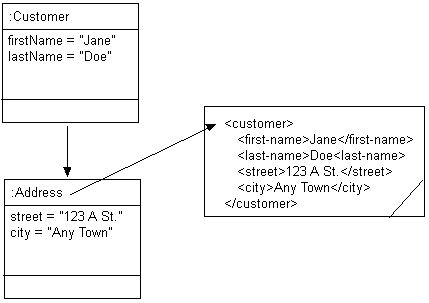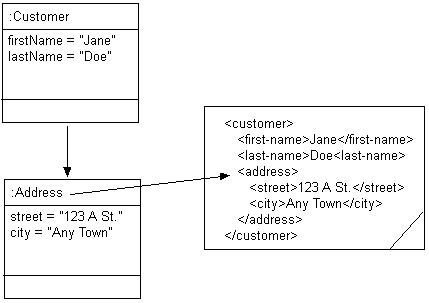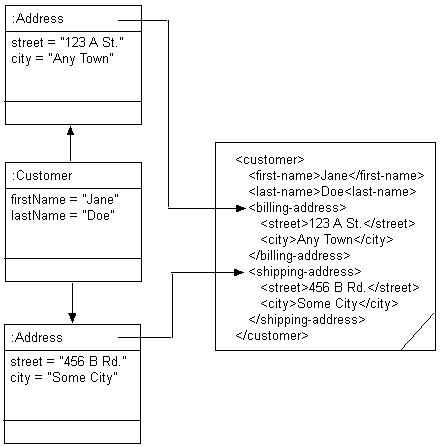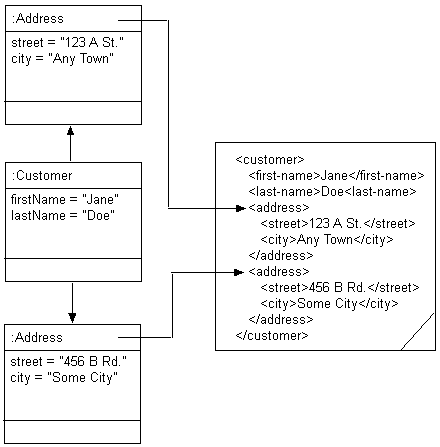|
Oracle TopLink Developer's Guide
10g Release 3 (10.1.3) B13593-01 |
|
 Previous |
 Next |
|
Oracle TopLink Developer's Guide
10g Release 3 (10.1.3) B13593-01 |
|
 Previous |
 Next |
XML composite object mappings represent a relationship between two classes. In XML, the "owned" class may be nested with the element tag representing the "owning" class. You can use a composite object XML mapping in the following scenarios:
See Chapter 69, "Configuring an XML Composite Object Mapping" for more information.
The composite object may be mapped to the same record as the parent.
|
Note: The nodes mapped to by the composite object must be sequential. |
Given the XML schema in Example 65-40, Figure 65-23 illustrates an XML composite object mapping into the parent record in a corresponding XML document. Example 65-41 shows how to configure this mapping in Java.
Example 65-40 Schema for XML Composite Object Mapping into the Parent Record
<?xml version="1.0" encoding="UTF-8"?> <xsd:schema xmlns:xsd="http://www.w3.org/2001/XMLSchema"> <xsd:element name="customer" type="customer-type"/> <xsd:complexType name="customer-type"> <xsd:sequence> <xsd:element name="first-name" type="xsd:string"/> <xsd:element name="last-name" type="xsd:string"/> <xsd:element name="street" type="xsd:string"/> <xsd:element name="city" type="xsd:string"/> </xsd:sequence> </xsd:complexType> </xsd:schema>
Figure 65-23 XML Composite Object Mapping into the Parent Record

Given the XML schema in Example 65-42, Figure 65-24 illustrates an XML composite object mapping to an element in a corresponding XML document. Example 65-43 shows how to configure this mapping in Java.
Example 65-42 Schema for XML Composite Object Mapping to an Element
<?xml version="1.0" encoding="UTF-8"?> <xsd:schema xmlns:xsd="http://www.w3.org/2001/XMLSchema"> <xsd:element name="customer" type="customer-type"/> <xsd:complexType name="customer-type"> <xsd:sequence> <xsd:element name="first-name" type="xsd:string"/> <xsd:element name="last-name" type="xsd:string"/> <xsd:element name="address"> <xsd:complexType> <xsd:sequence> <xsd:element name="street" type="xsd:string"/> <xsd:element name="city" type="xsd:string"/> </xsd:sequence> </xsd:complexType> </xsd:element> </xsd:sequence> </xsd:complexType> </xsd:schema>
Figure 65-24 XML Composite Object Mapping to an Element

An object may have multiple composite object mappings to the same reference class. Each composite object mapping must have a unique XPath. This example uses unique XPaths by name .
Given the XML schema in Example 65-44, Figure 65-25 illustrates an XML composite object mapping to different elements by name in a corresponding XML document. Example 65-45 shows how to configure this mapping in Java.
Example 65-44 Schema for XML Composite Object Mapping to Elements by Name
<?xml version="1.0" encoding="UTF-8"?> <xsd:schema xmlns:xsd="http://www.w3.org/2001/XMLSchema"> <xsd:element name="customer" type="customer-type"/> <xsd:complexType name="customer-type"> <xsd:sequence> <xsd:element name="first-name" type="xsd:string"/> <xsd:element name="last-name" type="xsd:string"/> <xsd:element name="billing-address" type="address-type"/> <xsd:element name="shipping-address" type="address-type"/> </xsd:sequence> </xsd:complexType> <xsd:complexType name="address-type"> <xsd:sequence> <xsd:element name="street" type="xsd:string"/> <xsd:element name="city" type="xsd:string"/> </xsd:sequence> </xsd:complexType> </xsd:schema>
Figure 65-25 XML Composite Object Mapping to Elements by Name

Example 65-45 Java for XML Composite Object Mapping to Elements by Name
XMLCompositeObjectMapping billingAddressMapping = new XMLCompositeObjectMapping();
billingAddressMapping.setAttributeName("billingAddress");
billingAddressMapping.setXPath("billing-address");
billingAddressMapping.setReferenceClass(Address.class);
XMLCompositeObjectMapping shippingAddressMapping = new XMLCompositeObjectMapping();
shippingAddressMapping.setAttributeName("shippingAddress");
shippingAddressMapping.setXPath("shipping-address");
shippingAddressMapping.setReferenceClass(Address.class);
An object may have multiple composite object mappings to the same reference class. Each composite object mapping must have a unique XPath. This example uses unique XPaths by position.
Given the XML schema in Example 65-44, Figure 65-25 illustrates an XML composite object mapping to different elements by position in a corresponding XML document. Example 65-45 shows how to configure this mapping in Java.
Example 65-46 Schema for XML Composite Object Mapping to Elements by Position
<?xml version="1.0" encoding="UTF-8"?> <xsd:schema xmlns:xsd="http://www.w3.org/2001/XMLSchema"> <xsd:element name="customer" type="customer-type"/> <xsd:complexType name="customer-type"> <xsd:sequence> <xsd:element name="first-name" type="xsd:string"/> <xsd:element name="last-name" type="xsd:string"/> <xsd:element name="address" maxOccurs="2"> <xsd:complexType> <xsd:sequence> <xsd:element name="street" type="xsd:string"/> <xsd:element name="city" type="xsd:string"/> </xsd:sequence> </xsd:complexType> </xsd:element> </xsd:sequence> </xsd:complexType> </xsd:schema>
Figure 65-26 XML Composite Object Mapping to Elements by Position

Example 65-47 Java for XML Composite Object Mapping to Elements by Position
XMLCompositeObjectMapping billingAddressMapping = new XMLCompositeObjectMapping();
billinAddressMapping.setAttributeName("billingAddress");
billinAddressMapping.setXPath("address[1]");
billinAddressMapping.setReferenceClass(Address.class);
XMLCompositeObjectMapping shippingAddressMapping = new XMLCompositeObjectMapping();
shippingAddressMapping.setAttributeName("shippingAddress");
shippingAddressMapping.setXPath("address[2]");
shippingAddressMapping.setReferenceClass(Address.class);